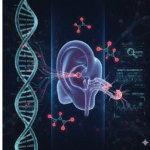A recent study has taken a major step forward in understanding the brain’s involvement in driving unhealthy eating behaviors, particularly the consumption of high-fat and high-sugar foods. This research, led by neuroscientists, pinpoints particular neurons within the brain’s hypothalamus that play a critical role in regulating the intake of these calorie-dense nutrients. The findings could not only help explain why we often crave unhealthy foods but also open the door for developing potential treatments for obesity, diabetes, and other metabolic disorders.
The hypothalamus, a small but vital region of the brain, has long been known to regulate a variety of functions related to hunger, satiety, and energy balance. However, until now, scientists lacked a comprehensive understanding of the specific neural mechanisms that drive our cravings for fat and sugar, two of the most commonly overconsumed food groups in modern diets. This new study uncovers key neurons that actively control our desire for these nutrient-rich, yet often overindulged foods.
Decoding the Brain’s Neuronal Responses to Fat and Sugar

Using cutting-edge techniques such as optogenetics—an innovative tool that allows researchers to control specific neurons with light—and advanced neural recording, the team was able to map out the complex networks that are activated during the consumption of fat and sugar. Their findings revealed that certain neurons in the hypothalamus become highly active when fatty or sugary foods are consumed, triggering pleasure and rewarding feelings. This response plays a crucial role in reinforcing the desire to seek out these energy-dense foods.
Interestingly, the study also discovered that not all neurons in the hypothalamus share the same function. Some neurons actually act as a regulatory mechanism, attempting to counterbalance the overconsumption of fats and sugars. This balancing act between the neurons that stimulate cravings and those that promote satiety helps maintain a delicate equilibrium in energy intake. However, when this balance is disrupted—such as by chronic overconsumption of unhealthy foods—it can lead to negative consequences, including overeating, weight gain, and the development of metabolic diseases like obesity and diabetes.
The Brain’s Reward System and Food Choices
One of the most striking revelations from this study is the direct connection between the brain’s reward system and food choice behavior. The research suggests that when high-fat or high-sugar foods are consumed, the brain’s reward circuits are activated, leading to a feeling of pleasure. This makes these foods particularly reinforcing, creating a feedback loop where individuals are driven to seek out these nutrient-rich but often unhealthy options repeatedly.
The study suggests that this biological wiring could explain why individuals often crave high-fat and high-sugar foods, even when healthier options are available. These cravings are not purely psychological but are deeply embedded in the brain’s reward system. For many people, this becomes a cycle that can be difficult to break, leading to patterns of overeating and poor dietary habits.
Implications for Obesity and Metabolic Disorders
The implications of these findings are far-reaching, especially in the context of the global obesity epidemic. Obesity and related conditions like type 2 diabetes are major public health concerns, and understanding the brain’s role in regulating food intake could be key to developing more effective treatments. If researchers can pinpoint exactly how these neurons are activated and what triggers their response, they may be able to develop therapeutic strategies aimed at modulating these brain circuits.
For example, interventions that target the neurons responsible for promoting cravings for fat and sugar could help individuals reduce their intake of these foods. Medications or behavioral therapies designed to alter the brain’s reward response could make it easier for individuals to make healthier food choices and, in turn, prevent or manage obesity and its associated health risks.
The Path Forward: Neurobiological Approaches to Healthy Eating

This new study represents a significant step forward in understanding how the brain influences our dietary behaviors. It underscores the complexity of the brain’s role in managing energy intake and the delicate balance required to maintain a healthy weight. With further research, scientists may develop strategies to “reprogram” the brain’s response to high-fat and high-sugar foods, helping to curb unhealthy eating habits and address some of the most pressing health issues of our time.
Moreover, the study reinforces the idea that obesity is not simply a matter of willpower but is deeply influenced by the brain’s biological responses to food. As research into the neural mechanisms of eating continues to evolve, it is becoming increasingly clear that personalized treatments targeting these brain circuits could provide a promising solution for those struggling with obesity and related diseases.
Wrap up
In conclusion, this landmark research is not only an exciting step in neuroscience but also a potential breakthrough for public health. By shedding light on the specific neurons driving the consumption of fat and sugar, scientists have opened the door to new treatments and strategies for combating overeating, obesity, and metabolic disorders—offering hope for healthier futures worldwide.
By revealing the complex neural pathways responsible for fat and sugar cravings, this study highlights the deep-rooted nature of unhealthy eating behaviors and presents novel approaches to addressing global health issues. With further exploration, these findings may pave the way for targeted therapies that help individuals regain control over their dietary choices, ultimately improving overall well-being.





